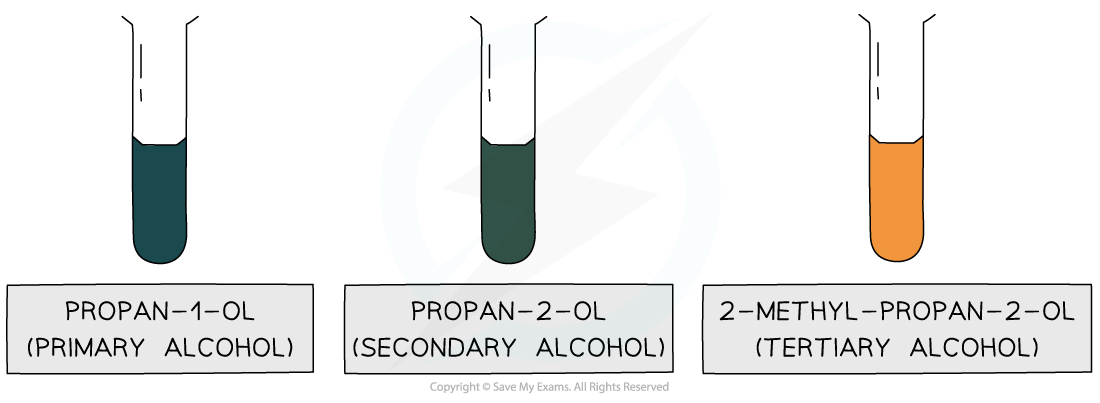Classifying & Testing for Alcohols (Cambridge (CIE) AS Chemistry): Revision Note
Exam code: 9701
Classifying Alcohols
Primary alcohols are alcohols in which the carbon atom bonded to the -OH group is attached to one other carbon atom (or alkyl group)
Secondary alcohols are alcohols in which the carbon atom bonded to the -OH group is attached to two other carbon atoms (or alkyl groups)
Tertiary alcohols are alcohols in which the carbon atom bonded to the -OH group is attached to three other carbon atoms (or alkyl groups)
Primary, secondary and tertiary alcohols

Only primary and secondary alcohols can get oxidised when mildly oxidised with acidified K2Cr2O7
Primary alcohols get mildly oxidised to aldehydes
Secondary alcohols get mildly oxidized to ketones
Tertiary alcohols do not undergo oxidation with acidified K2Cr2O7
Therefore, only the oxidation of primary and secondary alcohols will change the colour of K2Cr2O7 solution as the orange Cr2O72- ions are reduced to green Cr3+ ions
Testing for alcohols

Test for Alcohols
Tri-iodomethane (also called iodoform) is a yellow precipitate
It is formed from the reaction of iodine in an alkaline solution with methyl ketones
Methyl ketones are compounds that have a CH3CO-group
Ethanal also contains a CH3CO- group and therefore also forms a yellow precipitate with iodoform
The reagent is heated with an alkaline solution of iodine
This reaction involves a halogenation and hydrolysis step
In the halogenation step, all three H-atoms in the -CH3 (methyl) group are replaced with iodine atoms, forming a -CI3 group
The intermediate compound is hydrolysed by an alkaline solution to form a sodium salt (RCO2- Na+) and a yellow precipitate of CHI3
The iodoform reaction

Iodoform & alcohols
The position of a secondary alcohol group in a molecule can be identified using the iodoform test with iodine in alkaline solution
If the –OH group is attached to a carbon atom that is next to a methyl group, the alcohol can be oxidised by the alkaline iodine to form a methyl ketone (RCOCH3)
The methyl ketone then undergoes:
Halogenation, where the three hydrogen atoms of the methyl group are replaced by iodine atoms (–CI3), followed by
Hydrolysis, forming a sodium carboxylate salt and a yellow precipitate of iodoform (CHI3)
A positive result (yellow precipitate) indicates that the alcohol has the structure CH₃CH(OH)R
No precipitate means the secondary alcohol is not adjacent to a methyl group and therefore cannot form a methyl ketone intermediate
Using the iodoform test


Unlock more, it's free!
Did this page help you?